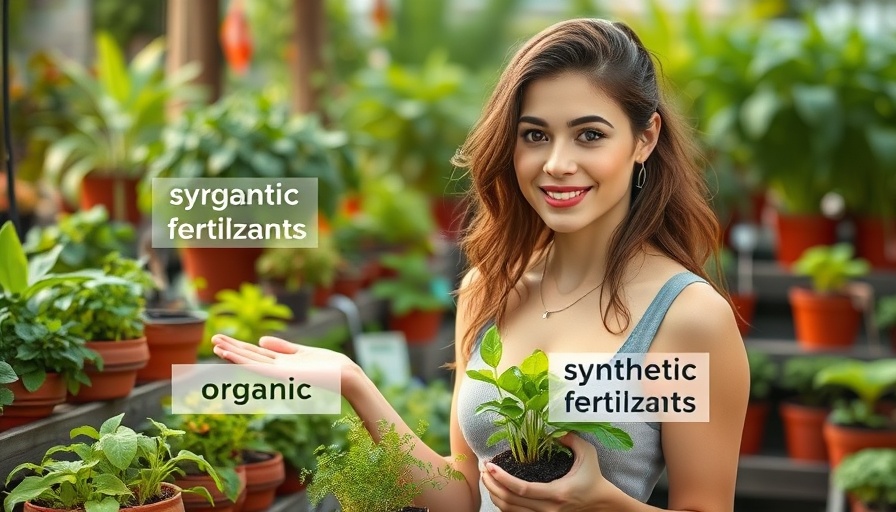
The Mystery of Soilless Mediums in Gardening: What You Need to Know
For many gardeners, particularly those in the Okanagan, the question of how to effectively use soilless planting mediums is a crucial one. With the rise of unconventional gardening methods, such as container gardening and hydroponics, understanding what makes these techniques effective can set your garden apart.
In 'Organic Fertilizer in Pots? It Doesn’t Work Unless You Do THIS', the discussion dives into effective strategies for using organic fertilizers in soilless gardening, exploring key insights that sparked deeper analysis on our end.
Soilless mediums, which include materials like coconut coir, perlite, and vermiculite, are popular among urban gardeners who may lack access to rich soil. However, as Ashley points out in her examination of organic fertilizers and soilless environments, these mediums come with an important caveat: they are often microbially inert. Without microbial activity, nutrient cycling is severely hampered, compromising the efficiency of organic fertilizers.
Why Microbes Matter in Plant Nutrition
The significance of microbes in soilless mediums cannot be overstated. In fact, a study published in Soil Ecology indicates that microbial activity can be up to 90% lower in soilless mediums compared to traditional mineral soils. This dramatic difference means that when gardeners apply organic fertilizers, they may not experience the anticipated benefits. Without the necessary microbes to break down organic matter, these fertilizers are left to linger in the medium, often resulting in unpleasant odors without any real advantage for plant growth.
Overcoming the Challenges of Soilless Gardening
Fortunately, there are effective strategies to enhance the performance of soilless mediums. Inoculating these systems with the right microbial agents can drastically improve nutrient bioavailability. For example, adding worm castings has shown a potential 17% increase in microbial activity. Incorporating 10-20% worm castings by volume throughout your container could create a thriving environment for plants.
Additionally, brewed compost teas can serve as a microbial booster, although opinions on their effectiveness can vary among gardeners. Regular application can help enhance microbial diversity and density, leading to healthier plants.
Embracing Synthetic Fertilizers: A Practical Approach
While organic methods have their benefits, many gardeners find synthetic fertilizers easier and more reliable. Synthetic options deliver water-soluble nutrients that plants can access immediately, without the need for microbes to mineralize compounds. This has shown consistent results in growth performance, particularly for young plants in hydroponic or soilless settings.
A review from 2020 in Agronomy supports the effectiveness of synthetic fertilizers in hydroponic systems, noting that they perform better than organic counterparts due to their efficiency. In the early stages of plant growth, having ready access to nutrients has been shown to give a significant advantage.
The Hybrid Approach: Best of Both Worlds?
Many gardeners are now advocating for a hybrid approach to fertilization. This method combines synthetic fertilizers with microbially active ingredients. By being careful not to overdo it on any one side, a balanced nutrient profile can emerge, yielding great results.
One of the primary challenges, as highlighted by Ashley, is the danger of salt buildup with synthetic applications—especially in closed systems where drainage is poor. Alternating between organic and synthetic fertilizers might provide the balanced approach gardeners seek, combining quick nutrient accessibility along with the benefits of organic amendments.
Practical Tips for Okanagan Gardeners
If you are navigating the world of soilless gardening in the Okanagan, here are a few practical tips:
- Inoculate Wisely: Use microbial inoculants or worm castings to prime your potting mix for better nutrient absorption.
- Avoid Overwatering: High moisture levels without the right aeration can lead to anaerobic conditions, harming beneficial microbes.
- Adapt Your Strategy: Be open to using a mix of organic and synthetic fertilizers—monitoring your plants can guide you in what works best.
Final Thoughts: Finding Your Balance
The journey to successful soilless gardening is not a straightforward path. In the video 'Organic Fertilizer in Pots? It Doesn’t Work Unless You Do THIS', Ashley shares valuable insights about the relationship between microbes and nutrients, encouraging us to think critically about our fertilizer choices. Whether you choose organic, synthetic, or a combination of both, understanding the underlying science will undoubtedly enhance your gardening experience.
Whether you're a seasoned gardener or new to the hobby, being informed about the best practices in nutrient application can transform your gardening success. Explore your options, listen to your plants, and don't hesitate to experiment!
 Add Row
Add Row  Add
Add 




Write A Comment